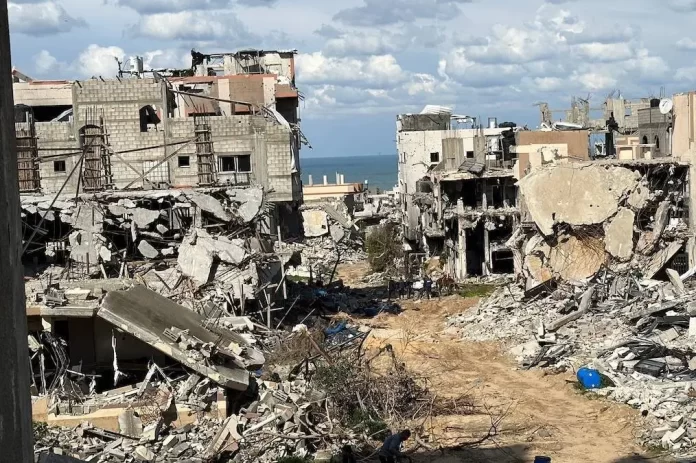Hamami’s report provides new context to many of the fabrications, including the allegations of rape and the beheading of babies. The Palestinian researcher shows how, in an attempt to garner support for their military operation, the Israeli authorities employed specific phrases in the media, such as describing the Hamas attack as the “worst atrocity ever witnessed in the region” and an “unprecedented massacre.”
29 February 2024
A new report by Palestinian researcher Dr Ibrahim Hamami casts doubt on Israel’s account of the 7 October attacks. Hamami’s report – What really happened on October the 7th? – critically examines the Israeli narrative that was presented by the Hebrew media, which alleged that Hamas intentionally planned to target civilians during its operation on Gaza’s border areas and settlements.
Specifically, the report challenges the figures released by the Israeli occupation forces and addresses the question of who bears responsibility for civilian casualties on that day.
Hamami’s research provides vital context overlooked in the dominant Israeli narrative. Critics argue that the Israeli narrative, which includes shocking details of rape and the beheading of babies, has been used to justify its genocidal military offensive against Palestinians in Gaza.
The report comes as further doubt is cast on the sensational New York Times story alleging that rape was used by Palestinian fighters as a weapon of war on 7 October. Questions centre around Anat Schwartz, an Israeli filmmaker who, it is reported, had no prior experience in journalism. Schwartz co-authored several questionable reports for the NYT about sexual violence.
Researchers found that Schwartz had earlier expressed inflammatory views on social media. Screenshots show her “liking” posts spreading the false “40 beheaded babies” rumour and calling for the slaughter of Palestinians as “human animals”. One of her co-authors is said to be her nephew Adam Sella.
Hiring someone with such extreme, publicly stated biases to report on a highly contentious topic violates standard journalistic guidelines on objectivity. The NYT failed to assign experienced journalists to such a sensitive story.
Further doubts emerged about the positive portrayal of Zaka, an Israeli volunteer group that recovers dead bodies and body parts for burial. A later Haaretz investigation accused Zaka personnel of negligence and spreading misinformation in their testimonies about 7 October.
The New York Times’ biases and lack of impartiality in its coverage of events on 7 October have undermined trust in its reporting. Last month, it pulled a high-profile episode of its podcast “The Daily” about sexual violence perpetrated by Hamas on 7 October amid a furious internal debate about the strength of the paper’s original reporting on the subject.
Hamami’s report provides new context to many of the fabrications, including the allegations of rape and the beheading of babies. The Palestinian researcher shows how, in an attempt to garner support for their military operation, the Israeli authorities employed specific phrases in the media, such as describing the Hamas attack as the “worst atrocity ever witnessed in the region” and an “unprecedented massacre.” He draws parallels with historical events, emphasising that the incidents were surpassed by the brutality of the Sabra and Shatila massacre in 1982 and, further afield, the Srebrenica massacre in 1995.
After explaining that the 7 October attack must be situated within the broader context of Israel’s decades-long illegal occupation, Hamami proceeds to refute the assertions put forth by the apartheid state across the five chapters of the report.
In chapter one, for example, the researcher disputes Israel’s claims about the number of casualties. The figure is currently placed at 1,139 killed, including 695 civilians. Initially, however, a figure of 1,400 was alleged, including 863 civilians. “The lack of scrutiny in the dissemination of these numbers raises questions about the accuracy and intent behind the information shared by both Israeli sources and the Western media,” says Hamami. The Israeli narrative, he adds, “has consistently demonstrated a penchant for blatant falsehoods…”
Although the narrative pushed by the mainstream media and Western politicians generally claims that “1,200 Israelis were killed by Hamas” on 7 October, there is now “no room for doubt that Israeli forces indiscriminately fired upon their own citizens, resulting in an unknown number of casualties. Hamami cites Israeli military sources showing that orders were given to bomb civilians amidst the chaos. Israeli witness testimonies confirm the military’s targeting of civilians at the Nova Music Festival and kibbutz, where casualties were highest. Images are provided of destruction resembling tank and helicopter shell craters inconsistent with any possible damage caused by relatively lightly-armed Palestinians. The researcher also points out that Israel refuses point blank to investigate events transparently while attacking and actually criminalising any dissenting narratives.
Hamami concludes his report by summarising its key points and calling for an independent international investigation into the events of 7 October, and to hold accountable those responsible for targeting and killing civilians, regardless of their affiliation.




